View Maryland Counties
- Allegany
- Anne Arundel
- Baltimore City
- Baltimore County
- Calvert
- Caroline
- Carroll
- Cecil
- Charles
- Dorchester
- Frederick
- Garrett
- Harford
- Howard
- Kent
- Montgomery
- Prince George's
- Queen Anne's
- St. Mary's
- Somerset
- Talbot
- Washington
- Wicomico
- Worcester
Frederick County
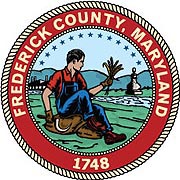 Frederick County was formed in 1748 from Baltimore and Prince George's counties. It is bordered to the north by Pennsylvania, the east by Carroll County, the south by Montgomery County and the Potomac River, and the west by Washington County. The county was probably named after Frederick Calvert (1731-1771), sixth and last Lord Baltimore.
Frederick County was formed in 1748 from Baltimore and Prince George's counties. It is bordered to the north by Pennsylvania, the east by Carroll County, the south by Montgomery County and the Potomac River, and the west by Washington County. The county was probably named after Frederick Calvert (1731-1771), sixth and last Lord Baltimore.
Frederick County boasts several interesting historic sites. Catoctin Furnace, now in ruins, is said to have supplied cannonballs for the siege of Yorktown during the Revolution. The shafts for Rumsey's steam engine were manufactures here as well as the plates for the Monitor and the Merrimac. The Hessian Barracks, located on the grounds of the Maryland School for the Deaf, were used as prisons during the Revolution. Among the captives were Hessian mercenaries who found much in common with the German speaking people of this region. Relations between the prisoners and the townspeople were generally friendly, with the Hessians making fireworks for the American victory celebration in 1783. Mount Olivet Cemetery is one of the few places where the U. S. flag is never lowered. Among those buried here are Francis Scott Key, Barbara Fritchie, and Thomas Johnson. Other locales of interest are the Monocacy Battlefield, Camp David, and the Seton Shrine.
Frederick County was also the home of Joseph Weller, who is credited with the first manufacture of friction matches in the United States. He was able to set up a plant to dip the wooden shafts into a mixture of his secret formula in the Old Match House in Thurmont. Luckily the success of his enterprise enabled him to expand and set up in a larger plant elsewhere, because it appears that his factory burned down twice. Other famous Marylanders also considered Frederick County their home. Thomas Johnson, member of the Continental Congress from Maryland and Maryland's first governor, had homes as Richfields and Rose Hill Manor. Richfields was also the birthplace of Winfield Scott Schley, the hero of Santiago. John Hanson also resided in Frederick while he served in the Continental Congress.
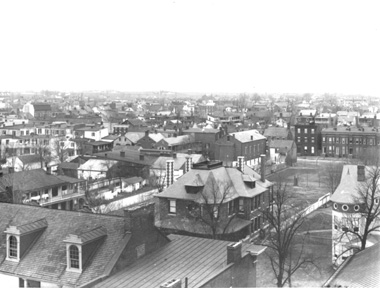
MSA SC 1477-5417
The City of Frederick was incorporated in 1817, but long before that the local community had prospered as a trading center for local farmers. This view was made from St. John's Church across Second Street.
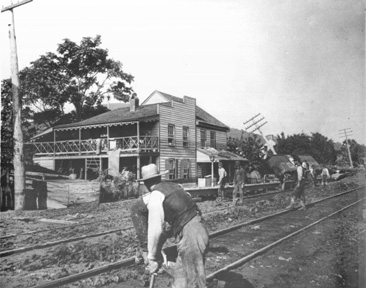
MSA SC 1477-5438
The flood of June 1889 caused extensive damage to communities along the Potomac rives and to the Chesapeake and Ohio Canal. Point of Rocks was among the towns where the water rose to dangerously high levels. By June 5, the community was hard at work cleaning up the damage to buildings and the railroad line.
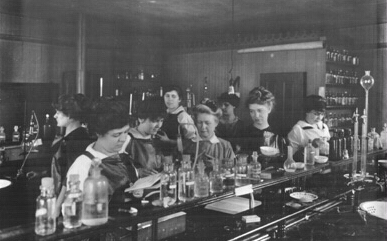
MSA SC 1477-5418
The Woman's College, founded in Frederick in 1893, became Hood College in 1912 to honor Margaret School Hood, a "generous friend" of the college. Here the students conduct experiments in the chemistry laboratory.
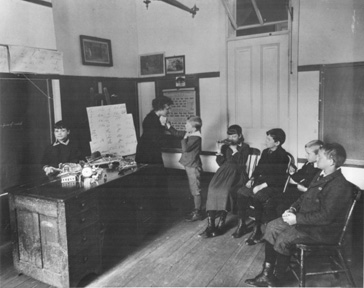
MSA SC 1477-5458
The Maryland School for the Deaf was located on Market Street in Frederick. Students were trained in academic subjects, calisthenics, and trades such as shoe repairing, printing, cabinet making, and domestic science.
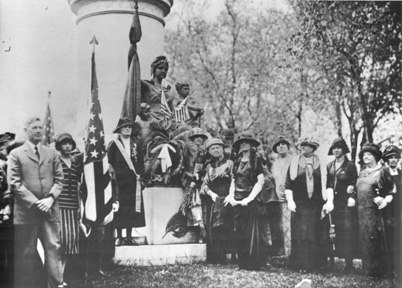
MSA SC 1477-5453
Francis Scott Key practiced law in Frederick for some time after 1800 To honor the one-time resident, the people of Frederick erected a monument to Key's memory.

